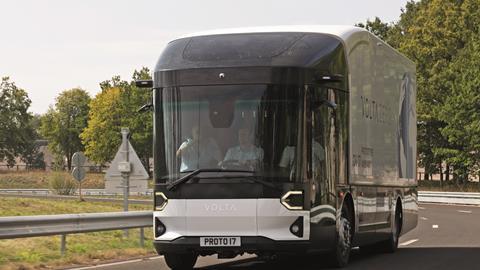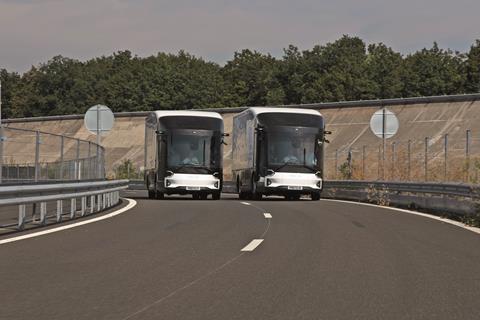Our colleagues at sister publication Commercial Motor were some of the first journalists to get a drive in the design verification prototypes of the Volta Zero in the summer of 2022. There remains some development work to complete before the vehicle is ready for full production, but the inital signs are very promising.
Our colleagues at sister publication Commercial Motor were some of the first journalists to get a drive in the design verification prototypes of the Volta Zero in the summer of 2022. There remains some development work to complete before the vehicle is ready for full production, but the inital signs are very promising.
The first of the new Volta Zero trucks will be built under a manufacturing deal with Steyr Automotive in Austria, although the company is looking at additional production facilities in North America. Volta trucks’ head office is in Stockholm, Sweden, but its engineering is led from the UK. Designed specifically for inner-city distribution, demand for the vehicle has already extended beyond the initial London and Paris launch markets. It will also be rolled out next year in Madrid, Milan, Germany and parts of the Netherlands. Volta has also confirmed it is designing and engineering 7.5- and 12-tonne Volta Zero variants. These will be visually identical at the front, but the 12-tonne vehicle will have a longer chassis and body and a second set of rear wheels and tyres to accommodate the increased payload.
A pilot fleet of this second product family is expected to be launched for customer trials in 2024, with series production due to start in early 2025. The company believes these additions will make a significant contribution to its plan to sell more than 27,000 vehicles per year by 2025.
Since launch, 50 customers have pre-ordered the Volta Zero and the company has a pipeline of more than 10,000 trucks and a pre-order bank value of approximately €1.4bn (£1.2bn). These pre-orders are the largest for full-electric trucks in Europe to date and are said to feature a number of major transport and fleet rental companies.
The initial concepts for the all-electric Volta Zero were created by Warwick-based consultancy Astheimer, which removed the traditional internal combustion engine and reimagined the way a truck is conventionally designed.
The 16-tonne vehicle is 9.46m in length, 3.47m high and 2.55m wide, with a wheelbase of 4.8m. It is limited to a top speed of 90km/h (56mph).
The panoramic view of the driver’s surroundings through a glasshouse-style cab is designed to deliver on TfL’s Direct Vision Standard rating for a 220-degree field of visibility around the vehicle. The protection of vulnerable road users is also enhanced by side-view cameras that replace traditional mirrors, a 360-degree birds-eye camera and blind-spot warning systems. The driver sits far lower than in a conventional truck, with their eye-line at around 1.8m. This mirrors the height of pedestrians and other road users.
The cabin is contemporary, spacious and light, with intuitive user interfaces. The central display conveys critical information, while touchscreens on each side are used for lights, climate control, navigation and trip planning, communication and in-cab media.
The driver sits in a central driving position, with easy access through fast-opening sliding doors on each side of the cabin. Thanks to the low seating position, the driver simply steps in and out of the cab rather than climbing up and down as in a traditional cab, which can create health and safety issues.
Volta will be the first full-electric medium-duty commercial vehicle manufacturer in Europe to use an innovative ePowertrain to drive the rear wheels, rather than the conventional electric motor and driveshaft set-up. The single electric motor, transmission and axle unit is supplied by Meritor of the US and is contained in a lightweight and compact unit that delivers an increased range. It also provides packaging benefits by freeing up space between the chassis rails, which is where the high-voltage battery is fitted for maximum safety.
The Volta Zero will use 150kWh to 225kWh of battery power, using two or three 75kWh battery packs. The Proterra-supplied batteries will give it a real-world range of up to 200km on a single charge with the long-range triple pack option. Volta believes this will be more than enough for most inner-city logistics and distribution vehicles that spend most of their operating time in slow-moving stop/start traffic.
Proterra batteries feature passive and active safety features, liquid thermal conditioning, and adhere to functional safety standards. They are designed to deliver more than 4,000 recharge cycles over 10 years, without significant degradation, to ensure the longevity of the vehicle.
The Volta Zero has been designed to optimise its load-carrying capacity, thus minimising the number of vehicles on a fleet, and consequent congestion. The principle is that it can operate in narrow city streets and undertake the role that three or four 3.5-tonne vehicles would ordinarily do.
The full-electric 16-tonne Volta Zero offers a payload of 8 tonnes, with an overall volume of 37.7cu m, designed to accommodate 16 Euro pallets. A refrigerated cargo box option is also available, without reducing overall cargo box volume.
A supply agreement with Carrier Transicold will integrate engineless Iceland all-electric refrigeration systems and PowerBox technology, thus further reducing CO2 or particulate emissions versus a normal engine-powered commercial vehicle chiller. Refrigerated vehicles destined for the UK will have their cargo box supplied and fitted at Paneltex in Hull.
On paper, the design makes sense. A central driving seat, as far forward in the cabin as possible, with large glass areas in front and to the side. In theory there’s a 220-degree field of vision. Better still is that passengers sit slightly behind you where they are not only no longer a hindrance to visibility; they’re also out of your peripheral vision, so don’t distract you as much.
Our first impressions.
While still in the early stages of its development, our drive in a design prototype left us with as many questions as it did answers, first and foremost of which was about the suitability of the central driving position.
The principle is sound – a central position gives maximum vision around the vehicle and supplemented with digital screens on the A-pillars and rear-view mirror you really do have a physical or digital 360-degree view of the area surrounding the truck.
What the concept doesn’t allow for is the ingrained ability of a human to judge distance and position from the traditional left or right seats of the cabin where you either use the gutter or the white lines as reference points. By sitting centrally, you partly remove that ability, and while it might not be a problem for a narrow McLaren supercar (the inevitable reference point for a centrally seated vehicle) the 2.55m Volta Zero isn’t quite so straightforward to position.
It doesn’t take long to quickly acclimatise to the centred seat and its benefits when tackling tight turns do become obvious with the clear view out of both sides, through the full-length bus-style doors, allowing you to actually see the road, kerb, bollards or other hazards. Supplemented with the comprehensive view from the digital wing mirrors it’s safe to say that Volta’s claims of superior visibility are well founded.
Nevertheless, you’ll still find yourself drifting out of position, something we did when mid-corner in a fast-sweeping right-hander, but the dynamics and centre of gravity of the truck also play their part here. Our unladen test vehicle was deceptively fast, hardly surprising thanks to its 200kW of continuous power and 570Nm of torque that is boosted to 250kW and up to 1,100Nm of torque at its peak. The Zero has a 2-speed transmission to help deliver those figures, with the second gear change occurring at a predetermined 45km/h.
Unlike the few other 2-speed electric trucks on the market that push the change through in a fraction of a second, the gear shift in our prototype vehicle was considerably slower and, when it did arrive, came with something of a clunk. While we’re told both the shift speed and smoothness can be adjusted, it is perhaps the point at which the change happens that could be the greatest inconvenience, as despite its likely uses as an urban delivery vehicle most drivers will be aiming for the 50km/h speed limit and may find between gears as they continually cross the change threshold.
Steering feedback is good, as is the ride comfort, but a smooth test track is no real test compared with a potholed city street. The low-down weight of the batteries helps to stabilise the truck and it feels neutral and balanced to a point, but like patting your head and rubbing your tummy at the same time it feels harder than it should to keep the truck centred in the lane. On normal roads with a load and other road users it’s unlikely to be such an issue.
The driving force behind the Zero, an eAxle from US manufacturer Meritor, has the ability to recover kinetic energy and return it to the Proterra battery pack (available as 150kWh or 225kWh options) but was not included on the prototype. We’re assured this will be changed and production models will have regenerative braking that is likely to be adjustable, or at the very least permanently on but more sensitive to the weight.
As a design prototype, the physical elements of the truck were in varying stages of production readiness. Many of the materials for example are low-grade plastics – something that Volta says will not be reflected in the finished product. While the wooden decking of the concept vehicle has been replaced with a more practical rubber floor that we are told will closely resemble the finished product, the shiny smooth black and grey plastics of the steering wheel, dash and surrounding trim will all be upgraded.
Functional items will have to change too. We found the indicator and wiper controls to be too far down from the steering wheel, and while the wheel is rake and reach adjustable, there’s the need for a tilt adjustment if drivers of all heights are to comfortably see the digital display, which in our normal seat and steering wheel position was obscured by the upper rim of the wheel. Instead, we had to sit closer and with the wheel far more upright than we would like, something that would quickly fatigue any driver.
Prototyping is all about ironing out the bugs and Volta was frank about the shortcomings of its test vehicle, which included a woefully weak air-conditioning system unable to keep up with the baking heat of a test track in summer. Other omissions and oversights, however, like regenerative braking and the obscured dash, should probably have been addressed to give not only the media but the many prospective customers that Volta has been courting a greater indication of the finished product.
Those issues aside, the Volta Zero is a test case for a new concept of a central seat and 1.8m height eye-to-eye driving position that will make urban trucks safer. Judging the Zero on that criteria alone, we would have to say it is a great success.


















